Lingling Li
SoccerNet 2025 Challenges Results
Aug 26, 2025Abstract:The SoccerNet 2025 Challenges mark the fifth annual edition of the SoccerNet open benchmarking effort, dedicated to advancing computer vision research in football video understanding. This year's challenges span four vision-based tasks: (1) Team Ball Action Spotting, focused on detecting ball-related actions in football broadcasts and assigning actions to teams; (2) Monocular Depth Estimation, targeting the recovery of scene geometry from single-camera broadcast clips through relative depth estimation for each pixel; (3) Multi-View Foul Recognition, requiring the analysis of multiple synchronized camera views to classify fouls and their severity; and (4) Game State Reconstruction, aimed at localizing and identifying all players from a broadcast video to reconstruct the game state on a 2D top-view of the field. Across all tasks, participants were provided with large-scale annotated datasets, unified evaluation protocols, and strong baselines as starting points. This report presents the results of each challenge, highlights the top-performing solutions, and provides insights into the progress made by the community. The SoccerNet Challenges continue to serve as a driving force for reproducible, open research at the intersection of computer vision, artificial intelligence, and sports. Detailed information about the tasks, challenges, and leaderboards can be found at https://www.soccer-net.org, with baselines and development kits available at https://github.com/SoccerNet.
ContextRefine-CLIP for EPIC-KITCHENS-100 Multi-Instance Retrieval Challenge 2025
Jun 12, 2025Abstract:This report presents ContextRefine-CLIP (CR-CLIP), an efficient model for visual-textual multi-instance retrieval tasks. The approach is based on the dual-encoder AVION, on which we introduce a cross-modal attention flow module to achieve bidirectional dynamic interaction and refinement between visual and textual features to generate more context-aware joint representations. For soft-label relevance matrices provided in tasks such as EPIC-KITCHENS-100, CR-CLIP can work with Symmetric Multi-Similarity Loss to achieve more accurate semantic alignment and optimization using the refined features. Without using ensemble learning, the CR-CLIP model achieves 66.78mAP and 82.08nDCG on the EPIC-KITCHENS-100 public leaderboard, which significantly outperforms the baseline model and fully validates its effectiveness in cross-modal retrieval. The code will be released open-source on https://github.com/delCayr/ContextRefine-Clip
Logits DeConfusion with CLIP for Few-Shot Learning
Apr 16, 2025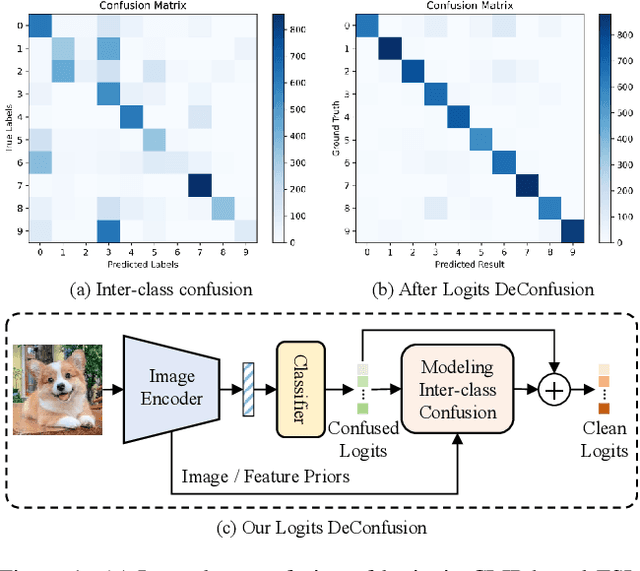
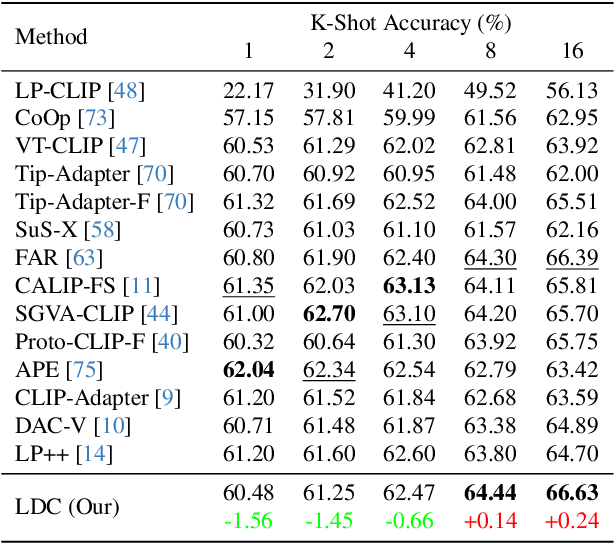
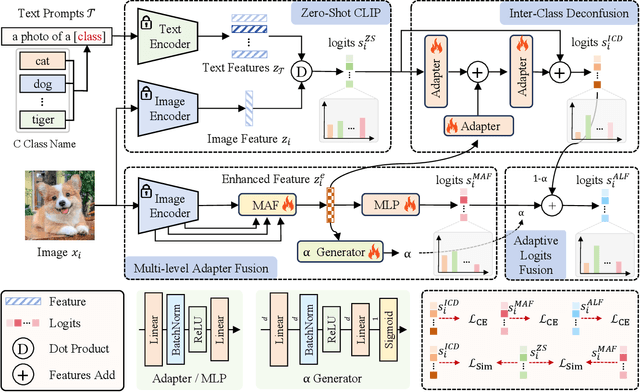
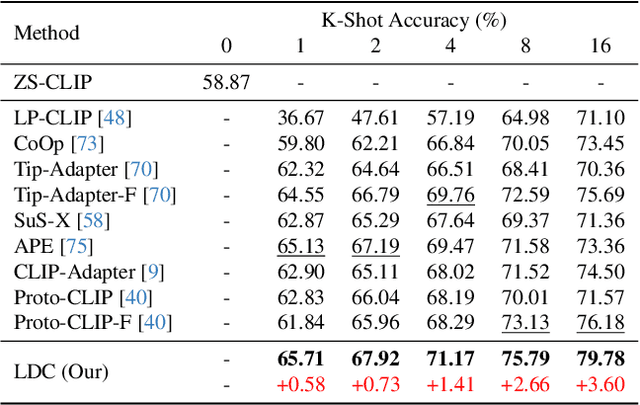
Abstract:With its powerful visual-language alignment capability, CLIP performs well in zero-shot and few-shot learning tasks. However, we found in experiments that CLIP's logits suffer from serious inter-class confusion problems in downstream tasks, and the ambiguity between categories seriously affects the accuracy. To address this challenge, we propose a novel method called Logits DeConfusion, which effectively learns and eliminates inter-class confusion in logits by combining our Multi-level Adapter Fusion (MAF) module with our Inter-Class Deconfusion (ICD) module. Our MAF extracts features from different levels and fuses them uniformly to enhance feature representation. Our ICD learnably eliminates inter-class confusion in logits with a residual structure. Experimental results show that our method can significantly improve the classification performance and alleviate the inter-class confusion problem. The code is available at https://github.com/LiShuo1001/LDC.
PVUW 2025 Challenge Report: Advances in Pixel-level Understanding of Complex Videos in the Wild
Apr 15, 2025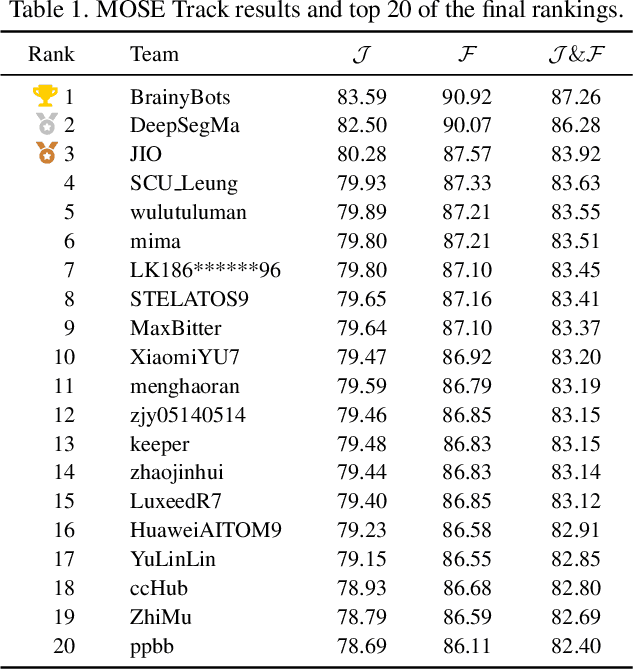
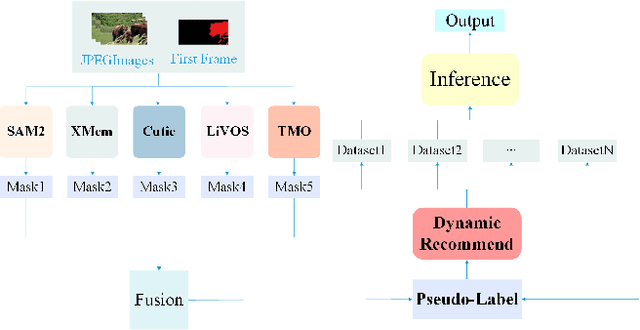
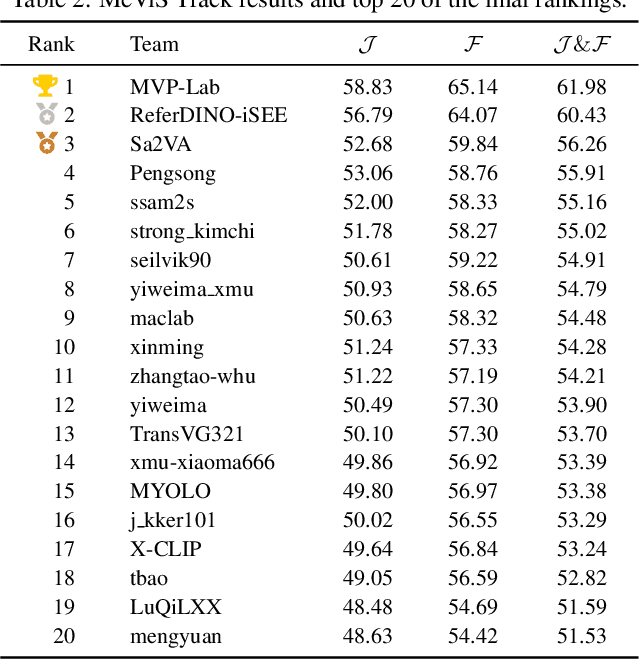
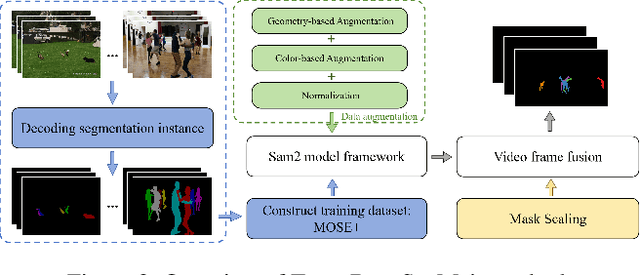
Abstract:This report provides a comprehensive overview of the 4th Pixel-level Video Understanding in the Wild (PVUW) Challenge, held in conjunction with CVPR 2025. It summarizes the challenge outcomes, participating methodologies, and future research directions. The challenge features two tracks: MOSE, which focuses on complex scene video object segmentation, and MeViS, which targets motion-guided, language-based video segmentation. Both tracks introduce new, more challenging datasets designed to better reflect real-world scenarios. Through detailed evaluation and analysis, the challenge offers valuable insights into the current state-of-the-art and emerging trends in complex video segmentation. More information can be found on the workshop website: https://pvuw.github.io/.
STSeg-Complex Video Object Segmentation: The 1st Solution for 4th PVUW MOSE Challenge
Apr 11, 2025

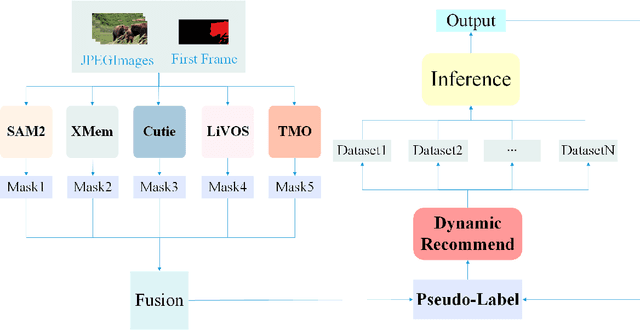

Abstract:Segmentation of video objects in complex scenarios is highly challenging, and the MOSE dataset has significantly contributed to the development of this field. This technical report details the STSeg solution proposed by the "imaplus" team.By finetuning SAM2 and the unsupervised model TMO on the MOSE dataset, the STSeg solution demonstrates remarkable advantages in handling complex object motions and long-video sequences. In the inference phase, an Adaptive Pseudo-labels Guided Model Refinement Pipeline is adopted to intelligently select appropriate models for processing each video. Through finetuning the models and employing the Adaptive Pseudo-labels Guided Model Refinement Pipeline in the inference phase, the STSeg solution achieved a J&F score of 87.26% on the test set of the 2025 4th PVUW Challenge MOSE Track, securing the 1st place and advancing the technology for video object segmentation in complex scenarios.
Learning Evolution via Optimization Knowledge Adaptation
Jan 04, 2025



Abstract:Evolutionary algorithms (EAs) maintain populations through evolutionary operators to discover diverse solutions for complex tasks while gathering valuable knowledge, such as historical population data and fitness evaluations. However, traditional EAs face challenges in dynamically adapting to expanding knowledge bases, hindering the efficient exploitation of accumulated information and limiting adaptability to new situations. To address these issues, we introduce an Optimization Knowledge Adaptation Evolutionary Model (OKAEM), which features dynamic parameter adjustment using accumulated knowledge to enhance its optimization capabilities. OKAEM employs attention mechanisms to model the interactions among individuals, fitness landscapes, and genetic components separately, thereby parameterizing the evolutionary operators of selection, crossover, and mutation. These powerful learnable operators enable OKAEM to benefit from pre-learned extensive prior knowledge and self-tune with real-time evolutionary insights. Experimental results demonstrate that OKAEM: 1) exploits prior knowledge for significant performance gains across various knowledge transfer settings; 2) achieves competitive performance through self-tuning alone, even without prior knowledge; 3) outperforms state-of-the-art black-box baselines in a vision-language model tuning case; 4) can improve its optimization capabilities with growing knowledge; 5) is capable of emulating principles of natural selection and genetic recombination.
Knowledge-aware Evolutionary Graph Neural Architecture Search
Nov 26, 2024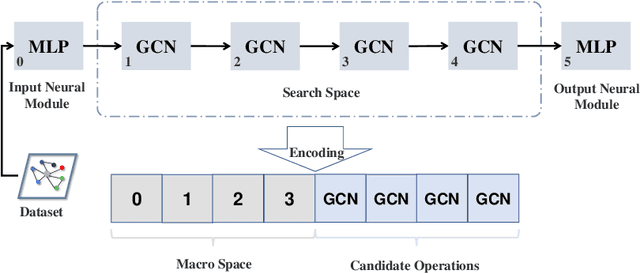
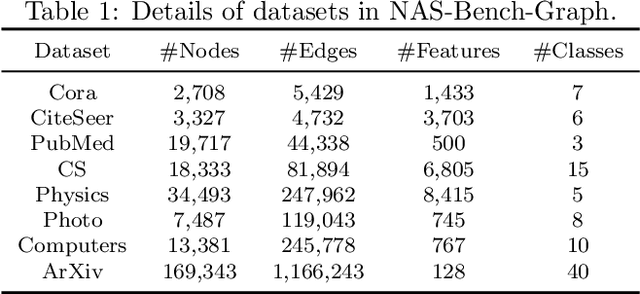
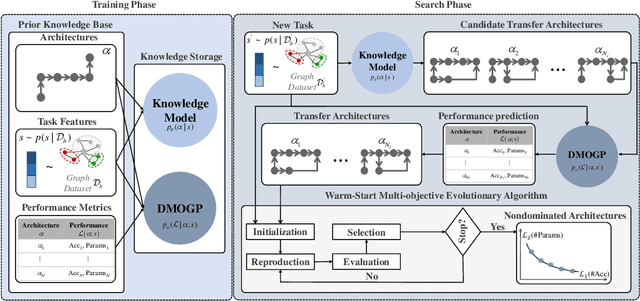

Abstract:Graph neural architecture search (GNAS) can customize high-performance graph neural network architectures for specific graph tasks or datasets. However, existing GNAS methods begin searching for architectures from a zero-knowledge state, ignoring the prior knowledge that may improve the search efficiency. The available knowledge base (e.g. NAS-Bench-Graph) contains many rich architectures and their multiple performance metrics, such as the accuracy (#Acc) and number of parameters (#Params). This study proposes exploiting such prior knowledge to accelerate the multi-objective evolutionary search on a new graph dataset, named knowledge-aware evolutionary GNAS (KEGNAS). KEGNAS employs the knowledge base to train a knowledge model and a deep multi-output Gaussian process (DMOGP) in one go, which generates and evaluates transfer architectures in only a few GPU seconds. The knowledge model first establishes a dataset-to-architecture mapping, which can quickly generate candidate transfer architectures for a new dataset. Subsequently, the DMOGP with architecture and dataset encodings is designed to predict multiple performance metrics for candidate transfer architectures on the new dataset. According to the predicted metrics, non-dominated candidate transfer architectures are selected to warm-start the multi-objective evolutionary algorithm for optimizing the #Acc and #Params on a new dataset. Empirical studies on NAS-Bench-Graph and five real-world datasets show that KEGNAS swiftly generates top-performance architectures, achieving 4.27% higher accuracy than advanced evolutionary baselines and 11.54% higher accuracy than advanced differentiable baselines. In addition, ablation studies demonstrate that the use of prior knowledge significantly improves the search performance.
Renormalized Connection for Scale-preferred Object Detection in Satellite Imagery
Sep 09, 2024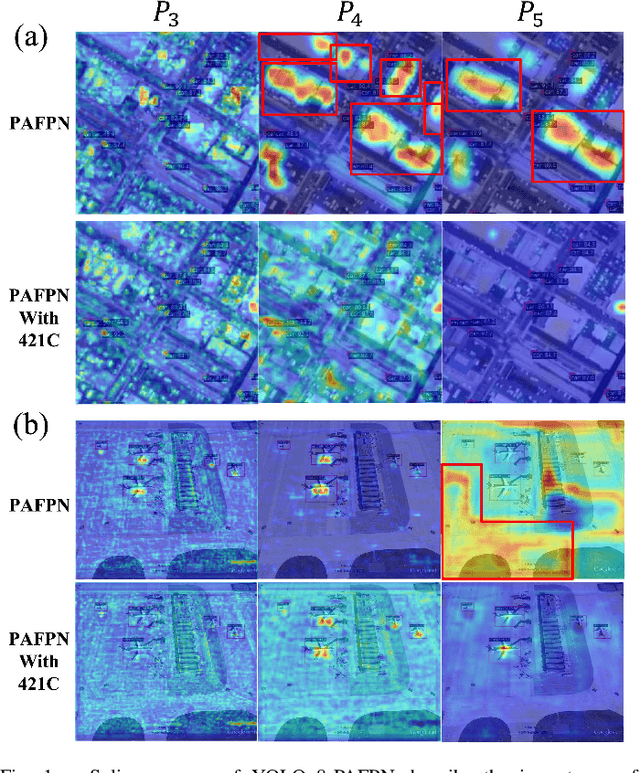
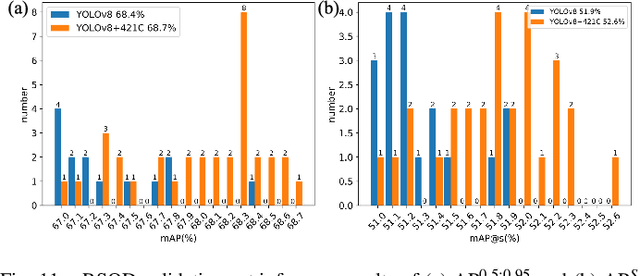
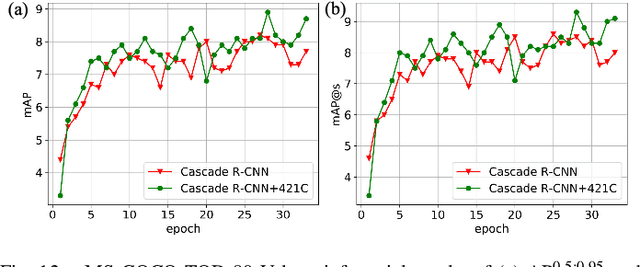
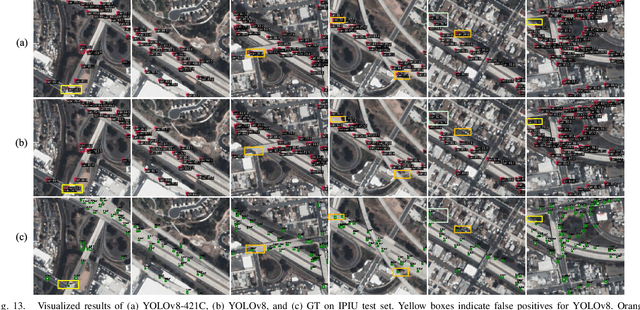
Abstract:Satellite imagery, due to its long-range imaging, brings with it a variety of scale-preferred tasks, such as the detection of tiny/small objects, making the precise localization and detection of small objects of interest a challenging task. In this article, we design a Knowledge Discovery Network (KDN) to implement the renormalization group theory in terms of efficient feature extraction. Renormalized connection (RC) on the KDN enables ``synergistic focusing'' of multi-scale features. Based on our observations of KDN, we abstract a class of RCs with different connection strengths, called n21C, and generalize it to FPN-based multi-branch detectors. In a series of FPN experiments on the scale-preferred tasks, we found that the ``divide-and-conquer'' idea of FPN severely hampers the detector's learning in the right direction due to the large number of large-scale negative samples and interference from background noise. Moreover, these negative samples cannot be eliminated by the focal loss function. The RCs extends the multi-level feature's ``divide-and-conquer'' mechanism of the FPN-based detectors to a wide range of scale-preferred tasks, and enables synergistic effects of multi-level features on the specific learning goal. In addition, interference activations in two aspects are greatly reduced and the detector learns in a more correct direction. Extensive experiments of 17 well-designed detection architectures embedded with n21s on five different levels of scale-preferred tasks validate the effectiveness and efficiency of the RCs. Especially the simplest linear form of RC, E421C performs well in all tasks and it satisfies the scaling property of RGT. We hope that our approach will transfer a large number of well-designed detectors from the computer vision community to the remote sensing community.
* 24 pages, 14 figures Journal
LSVOS Challenge 3rd Place Report: SAM2 and Cutie based VOS
Aug 21, 2024Abstract:Video Object Segmentation (VOS) presents several challenges, including object occlusion and fragmentation, the dis-appearance and re-appearance of objects, and tracking specific objects within crowded scenes. In this work, we combine the strengths of the state-of-the-art (SOTA) models SAM2 and Cutie to address these challenges. Additionally, we explore the impact of various hyperparameters on video instance segmentation performance. Our approach achieves a J\&F score of 0.7952 in the testing phase of LSVOS challenge VOS track, ranking third overall.
Fast and Efficient: Mask Neural Fields for 3D Scene Segmentation
Jul 01, 2024



Abstract:Understanding 3D scenes is a crucial challenge in computer vision research with applications spanning multiple domains. Recent advancements in distilling 2D vision-language foundation models into neural fields, like NeRF and 3DGS, enables open-vocabulary segmentation of 3D scenes from 2D multi-view images without the need for precise 3D annotations. While effective, however, the per-pixel distillation of high-dimensional CLIP features introduces ambiguity and necessitates complex regularization strategies, adding inefficiencies during training. This paper presents MaskField, which enables fast and efficient 3D open-vocabulary segmentation with neural fields under weak supervision. Unlike previous methods, MaskField distills masks rather than dense high-dimensional CLIP features. MaskFields employ neural fields as binary mask generators and supervise them with masks generated by SAM and classified by coarse CLIP features. MaskField overcomes the ambiguous object boundaries by naturally introducing SAM segmented object shapes without extra regularization during training. By circumventing the direct handling of high-dimensional CLIP features during training, MaskField is particularly compatible with explicit scene representations like 3DGS. Our extensive experiments show that MaskField not only surpasses prior state-of-the-art methods but also achieves remarkably fast convergence, outperforming previous methods with just 5 minutes of training. We hope that MaskField will inspire further exploration into how neural fields can be trained to comprehend 3D scenes from 2D models.
 Add to Chrome
Add to Chrome Add to Firefox
Add to Firefox Add to Edge
Add to Edge